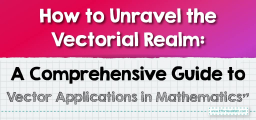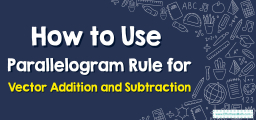How to Understand Dot Product and Cross-Product
The dot product outputs a scalar and captures the angle between two vectors. The cross product outputs a vector, which is perpendicular to the plane of the two input vectors and captures both the angle between the vectors and the plane in which they lie.
Both operations are foundational in physics, engineering, and computer science, especially in areas like mechanics, electromagnetism, and computer graphics.

Step-by-step Guide to Understand Dot Product and Cross-Product
Here is a step-by-step guide to understanding dot-product and cross-product:
Step 1: Introduction to the World of Vectors
Before we navigate through the enigmatic realms of dot and cross products, we must first familiarize ourselves with the primary citizens of this realm – vectors.
- Definition of a Vector:
- An entity characterized by both magnitude (length) and direction.
- Graphically represented as an arrow.
- E.g., \( \overrightarrow{A} \)\(=A_xi+A_yj \) where \( i \) and \( j \) are the unit vectors along the \(x\) and \(y\) axes, respectively.
- Vector Operations:
- Vectors can be added, subtracted, and scaled, leading to new vectors.
Step 2: Unraveling the Mysteries of the Dot Product
The dot product, also known as the scalar product, melds two vectors to produce a scalar. It’s the projection of one vector onto another.
- Geometrical Interpretation:
- The dot product of two vectors gives the product of their magnitudes and the cosine of the angle between them.
- Formula: \( \overrightarrow{A}⋅\overrightarrow{B}=\overrightarrow{∣A∣} \ \overrightarrow{∣B∣}cos(θ)\)
- If two vectors are perpendicular, their dot product is zero (because \( cos(90^\circ\)\(=0\)).
- If they are parallel, the dot product gives the product of their magnitudes.
- Algebraic Computation:
- For \( \overrightarrow{A}\)\(=A_xi+A_yj\) and \( \overrightarrow{B}\)\(=B_x i+B_y j\):
- Dot product: \( \overrightarrow{A}⋅ \overrightarrow{B}=A_xB_x+A_yB_y\)
- Applications:
- Checking orthogonality (perpendicularity) of vectors.
- Computing work in physics: Work = Force (dot) Displacement.
- Finding angles between vectors using the relationship with the cosine of the angle.
Step 3: The Cross-Product Conundrum in 2D
Though often associated with \(3\)-dimensional space, a variation of the cross-product can still be interpreted in \(2D\), albeit with certain peculiarities.
- Geometrical Interpretation:
- In \(3D\), the cross-product results in a vector. However, in \(2D\), it results in a scalar representing the (signed) area of the parallelogram spanned by two vectors.
- Formula: \(Area= \overrightarrow{∣A∣} \ \overrightarrow{∣B∣}sin(θ)\)
- Pseudo 2D Computation:
- To compute this in \(2D\), imagine both vectors as \(3D\) vectors with \(z\)-components as zero. E.g., \( \overrightarrow{A}\)\(=A_xi+A_yj+0k\) and \( \overrightarrow{B}\)\(=B_xi+B_yj+0k\)
- Then, compute the cross product as in \(3D\), but only consider the \(z\)-component (which will be a scalar in \(2D\) context): \( \overrightarrow{A}× \overrightarrow{B}=(A_xB_y−A_yB_x)k\)
- The magnitude of this value represents the area of the parallelogram spanned by \( \overrightarrow{A}\) and \( \overrightarrow{B}\).
- Applications:
- Determining clockwise or counterclockwise orientation of points in computational geometry.
- Finding the area bounded by two vectors.
Step 4: Wrapping Up & Reflection:
- While both dot and cross products involve angle relationships between vectors, they serve distinct purposes and yield different results: scalars vs. vectors (or in \(2D\), scalars vs. pseudo-scalars).
- This understanding lays the foundation for exploring more advanced vector topics, and its applications can be seen across diverse fields, from physics to computer graphics.
To truly grasp these concepts, one must not only understand them theoretically but also engage in practical exercises, visualizations, and real-world applications. Dive deep, and let the world of vectors unfold its wonders!
Examples:
Example 1:
Given vectors \( \overrightarrow{A}=(3,2)\) and \( \overrightarrow{B}=(−1,5)\), find \( \overrightarrow{A}∙ \overrightarrow{B}\).
Solution:
\( \overrightarrow{A}⋅ \overrightarrow{B}=A_xB_x+A_yB_y\)
\( \overrightarrow{A}⋅ \overrightarrow{B}=(3×−1)+(2×5)\)
\( \overrightarrow{A}⋅ \overrightarrow{B}=−3+10\)
\( \overrightarrow{A}⋅ \overrightarrow{B}=7\)
Example 2:
Given vectors \( \overrightarrow{E}=(5,-2)\) and \( \overrightarrow{F}=(-3,6)\), find \( \overrightarrow{E}× \overrightarrow{F}\).
Solution:
\( \overrightarrow{E}× \overrightarrow{F}=E_xF_y−E_yF_x\)
\( \overrightarrow{E}× \overrightarrow{F}=(5×6)−(−2×−3)\)
\( \overrightarrow{E}× \overrightarrow{F}=30−6\)
\( \overrightarrow{E}× \overrightarrow{F}=24\)
Related to This Article
More math articles
- Top 10 CLEP College Mathematics Prep Books (Our 2023 Favorite Picks)
- Number Properties Puzzle – Challenge 6
- Mastering the Metrics of Chance: A Complete Guide to Understanding Random Variables
- How to Compare Linear Functions Graphs and Equations
- How to Multiply Matrix? (+FREE Worksheet!)
- 8th Grade ACT Aspire Math FREE Sample Practice Questions
- The Math Detective: How to Find the Case of the Right Simulation that Represents the Situation
- Number Properties Puzzle -Critical Thinking 6
- How to Use Basic Techniques for Solving Trigonometric Equations
- How to Use Comparison test for Convergence
























What people say about "How to Understand Dot Product and Cross-Product - Effortless Math: We Help Students Learn to LOVE Mathematics"?
No one replied yet.